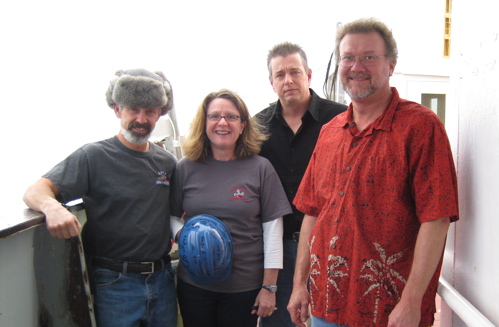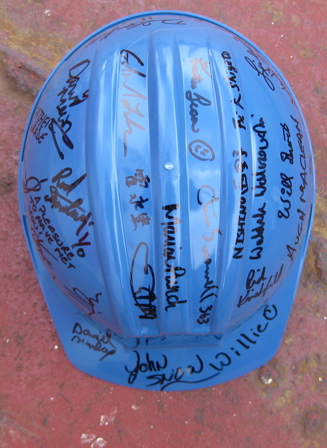Gerty WardAugust 19, 2008LSSL Ship's Log: 19082008 At 2210 on 19 Aug 2008, Third Mate Marian Punch piped, "We have finished work at the last science station. We are going home." After 32 days at sea, we are coming home. We have seen and done some amazing things. I have experienced so many "firsts" that I cannot list them all. Thank you to Rick Krishfield of WHOI who applied for a PolarTREC teacher, giving me the opportunity to join him on this expedition. Thank you to Rick, Will and Jim for allowing me to join them on the deck and on the ice. I can now rechain glass balls, thanks to Will and Jim.
Thank you to the officers and crew of the LSSL for taking the time to explain the ship and let me take their pictures, over and over. Thank you to the science team for patiently explaining oceanography, sometimes several times over, and for letting me photograph their every move. For those of you who have never been to sea (that would include me, prior to this cruise), I offer a simulation of ship life that you can run at home. How to Simulate Shipboard Life in your Home (with my sincere thanks to Don Stortts, LSSL) 1. While running this simulation, lock all your friends and family outside. Communicate only by email received 1X a day and costs $2 each. Make your email address so long and complicated that only 1 in 5 emails gets to you. In the middle of the simulation, cut off all emails, telephone and TV for 10 days. 2. Surround yourself with 77 strangers who smell and talk funny, who snore and swear continuously and can beat you at crib with their eyes closed. 3. Unplug all radios and TVs. Remove all DVDs except every one you did not like that you have watched in the past 3 years. Discover that you now like the violent and horror genres. 4. Issue each person a radio and designate one person to be The Bridge. When ever you use any appliance, tool or vehicle, call the Bridge before, during and after operations. The Bridge must record each activity and the time in two different notebooks. Monitor all electrical appliances hourly by recording vital parameters (plugged in, light comes on, etc.) Test garage door while blowing loud horn all day on Sunday. 5. Work in 18-hour cycles. Sleep for only 4 hours at a time with all the lights on. Put bed on rocking table. Have a child come into your room and yell into your ear periodically. At random intervals, add or subtract an hour from the time. Be sure to add all extra hours on to the night shift. 6. Ensure that all rare wildlife sightings occur when you are in the shower. 7. Line the bottom of each doorway with two layers of bricks. Go up and down the stairs 4 times before each meal. Have a child slam doors at irregular intervals. Leave all the exterior doors open for no reason (especially effective during a winter simulation). 8. Any and all exercise is to be done in one room without windows. Repeatedly change the incline on your treadmill to simulate ship movement. Play concert DVDs at highest possible volume. 9. Food should be served at 0730, 1130 and 1630, with coffee breaks every 45 minutes in between. You may NOT eat between 1630 and 0730. 10. After the simulation had been completed, obsessively look at photos of every event. Realize that you have established a wonderful and special bond with the 78 other participants and you have memories and experiences that you will never, ever forget. Rejoice in the realization that you are home -- the simulation is over -- UNTIL NEXT YEAR! Last updated: October 7, 2019 | |||||||||||||||||
Copyright ©2007 Woods Hole Oceanographic Institution, All Rights Reserved, Privacy Policy. | |||||||||||||||||




